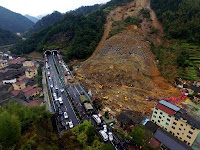Ninety-eight people have been confirmed dead and around 800 injured following a series of storms that battered coastal areas of Jiangsu Province, China, on Friday 24 June 2016. Windspeeds of 125 kilometers per hour were recored in Funing County, and witnesses reported seeing a tornado near the city of Yancheng. A factory belonging to GCL System Integration Technology Co Ltd has also been partially destroyed, including a store for hazardous chemicals, leading to concerns that water supplies could be contaminated.
Storm damage in Funing County following the storms that battered Jiangsu Province on 24 June 2016. AP.
Ocean storms form due to heating of air over the sea in tropical zones. As the air is heated the the air pressure drops and the air rises, causing new air to rush in from outside the forming storm zone. If this zone is sufficiently large, then it will be influenced by the Coriolis Effect, which loosely speaking means the winds closer to the equator will be faster than those further away, causing the storm to rotate, clockwise in the northern hemisphere and anticlockwise in the southern hemisphere.
Storm damaged buildings in Yangcheng following the storms that battered Jiangsu Province on 24 June 2016. AP.
Tropical storms are common in South China, but Jiangsu Provinc is in the northeast of the country and does not usually suffer such storms. Meteorologists in China have suggested the storms may be conneted to last year's El Niño conditions, which has brought unusual weather conditions around the Pacific and Indian oceans.
Movements of air masses and changes in precipitation in an El Niño weather system. Fiona Martin/NOAA.
The El Niño is the warm phase of a long-term climatic oscillation affecting the southern Pacific, which can influence the climate around the world. The onset of El Niño conditions is marked by a sharp rise in temperature and pressure over the southern Indian Ocean, which then moves eastward over the southern Pacific. This pulls rainfall with it, leading to higher rainfall over the Pacific and lower rainfall over South Asia. This reduced rainfall during the already hot and dry summer leads to soaring temperatures in southern Asia, followed by a rise in rainfall that often causes flooding in the Americas and sometimes Africa. Worryingly climatic predictions for the next century suggest that global warming could lead to more frequent and severe El Niño conditions, extreme weather conditions a common occurrence.
See also...
 Landslide kills six in Zhejiang Province, China. Six people have been confirmed dead following a landslide in the city of
Jiande in Zhejiang...
Landslide kills six in Zhejiang Province, China. Six people have been confirmed dead following a landslide in the city of
Jiande in Zhejiang... Multiple deaths following landslide in Zhejiang Province, China. Eleven people have been confirmed dead and another 26 are still missing
following a landslide that buried about 27 houses in the village of
Lidong in the Llandu District of Zhejiang Province at about 10.50 pm
local time on Friday 13 November 2015. The...
Multiple deaths following landslide in Zhejiang Province, China. Eleven people have been confirmed dead and another 26 are still missing
following a landslide that buried about 27 houses in the village of
Lidong in the Llandu District of Zhejiang Province at about 10.50 pm
local time on Friday 13 November 2015. The...  Earthquake in Anhui Province, China, kills at least two. Two people are known to have died and at least twelve more have been
injured following an Earthquake close to the city of Fuyang in Anhui
Province slightly before 2.15 pm local time (slightly before 6.15 am
GMT) on Saturday 14 March 2015, which was recorded by the...
Earthquake in Anhui Province, China, kills at least two. Two people are known to have died and at least twelve more have been
injured following an Earthquake close to the city of Fuyang in Anhui
Province slightly before 2.15 pm local time (slightly before 6.15 am
GMT) on Saturday 14 March 2015, which was recorded by the...Follow Sciency Thoughts on Facebook.



